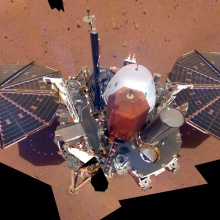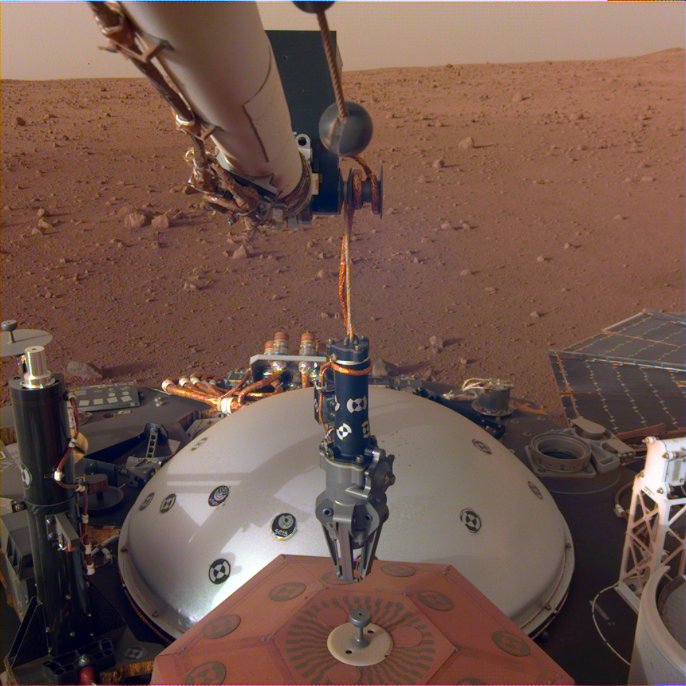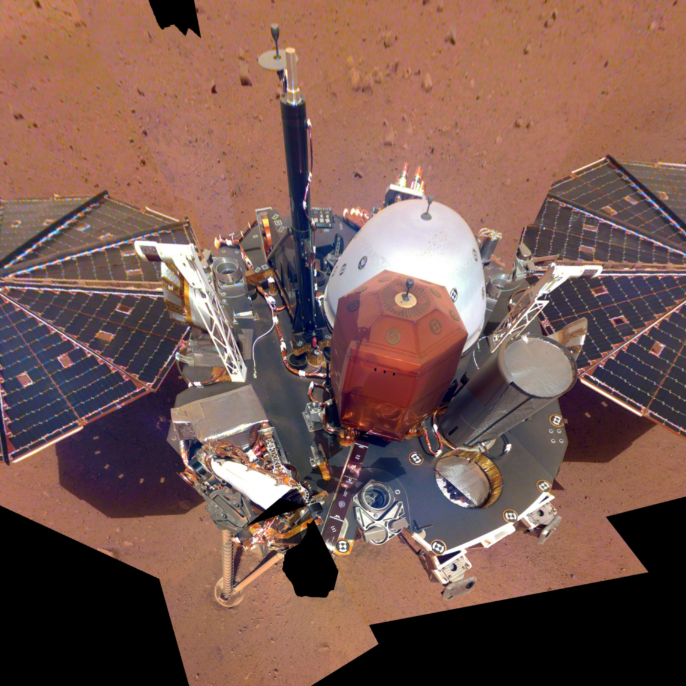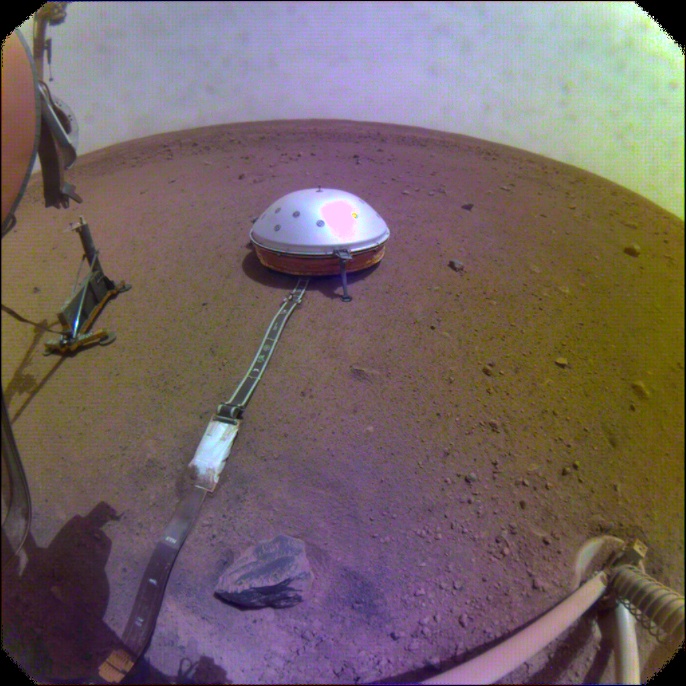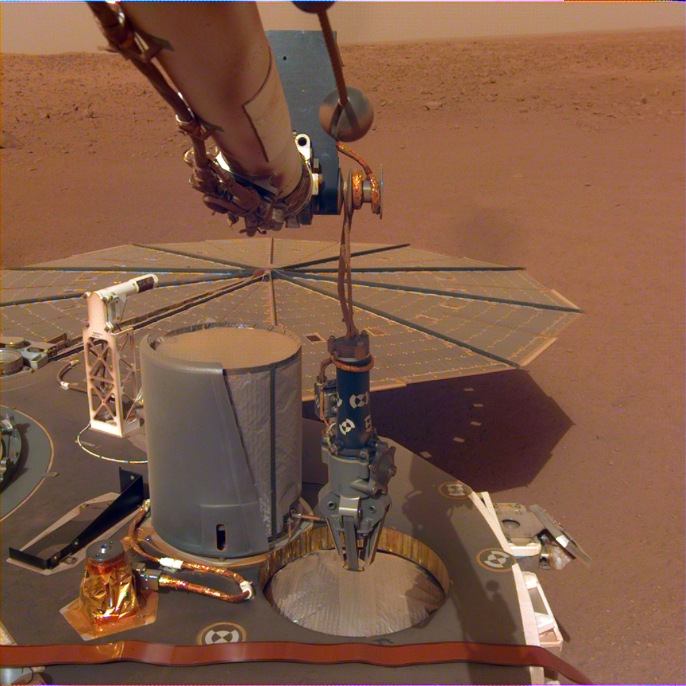One year after InSight (Interior Exploration using Seismic Investigations, Geodesy and Heat Transport) landed on Mars, the first results are now released. The results, which have been published in the journal Nature, shed new light on earthquakes on Mars, as well as its core, atmosphere, magnetic field and geology. InSight is a joint mission between the American space agency NASA and European partner institutions, such as the German Aerospace Center (DLR) and the French Aerospace agency CNES. It is the first mission to take a look deep under the surface of Mars, and should provide an insight into the structure of Mars such as the size and composition of the core as well as the thickness of the crust.
Earthquakes, dust devils and magnetic field pulses on Mars
A seismometer, which is one of the European contributions to the mission, measures the minute shaking of the Martian surface. In the run-up to the mission, the highly sensitive instrument was tested at the Black Forest Observatory in Schiltach, which is jointly run by the University of Stuttgart and the Karlsruhe Institute of Technology. Particularly good measuring conditions exist there due to the low seismic background noise in the region. The seismometer has measured more than 400 seismic signals on Mars in one year, of which the overwhelming majority were probably marsquakes. Scientist Dr. Rudolf Widmer-Schnidrig from the BFO is involved in evaluating the data. He tells us about his work on InSight:
What are your conclusions from inspecting the quakes on Mars?
The earthquakes are weaker than what we were hoping for. Comparing with seismograms collected on Earth and on the Moon (from the Apollo mission), we can say that quakes on Mars are more similar to those from the Moon‚- and that they can at most be compared with the tremors that we measure on volcanoes here on Earth. The seismic waves suggest that the crust of Mars is very heterogeneous. On the one hand this is unexpected, and on the other hand it makes interpreting the recorded waves a challenge. We need to develop new analysis methods.
What area of the InSight mission are you involved with in your research?
I work on the interaction between the Martian atmosphere and the solid surface. Fluctuations in pressure in the atmosphere are measured by the barometer on the InSight landing module. The seismometer which sits on the Martian surface also senses these fluctuations in pressure, because Mars is not a solid body but reacts elastically as soon as it is pressed. By comparing the stimulation from atmospheric pressure and the buckling in the Martian surface, we can estimate the elasticity of the upper layers beneath the seismometer.
The publications mention dust devils. What’s that all about?
The most common pressure signals are brief drops, caused by so-called dust devils. These are vortexes, which transport microscopically fine dust particles from the Martian surface into the upper atmosphere.These dust devils frequently happen in the afternoons. Unfortunately,attempts to photograph them have not yet been successful. Thoughby comparing two pictures from the ground around the landing modulewhich were taken at different times, it is possible to recognize dust which has gone missing or which has been moved around. We can take this as evidence that a dust devil has passed by. For some dust devils we observed that while it passed near by the lander theelectrical output of the solar cells has also briefly gone down, which can be interpreted as shadows being cast over the solar cells by the dust devil.
What do you have to be aware of when evaluating the data?
I am involved in identifying and removing artifacts in the seismometer data which are caused by the extreme environmental conditions on Mars. The outside temperature on Mars fluctuates by up to 80C during the course of a day, from -90C to -10C. As a result, the temperature inside the seismometer still fluctuates by around 10C despite the sophisticated thermal shielding. Temperature fluctuations like that in such a complex device lead to tension. This tension is suddenly released in the form of tiny little crackling noises. Removing these jumps is the first step in nearly every analysis of the Mars seismometer data.
What new findings have you gained in terms of magnetism?
From comparing measurements of the magnetic field variations on the Martian surface with magnetic field variations observed by satellites orbiting Mars we find that Mars’s crust has a high electrical conductivity. This is considered as an indication of liquids deep in the crust. At this point in time many of the findings are still preliminary. However, as the mission continues we’ll get more data that will be used to corroborate the new findings. The primary mission is set to last a full Martian year, which corresponds to two years on Earth.


